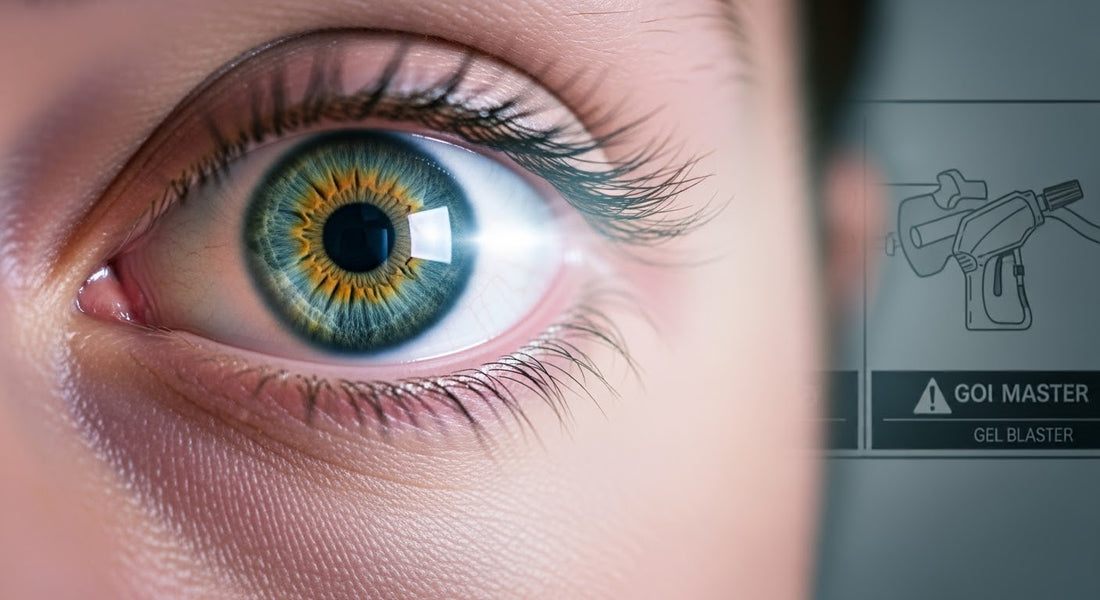
Gel Spray Gun Safety Myth Debunked
Share
📑 Table of Contents
- 1. Beyond the Hype: Toys? Weapons? First, Clarify the Origin of Safety Perception
- 2. The "Eye Protection Is Optional" Lie: Kinetic Impact in Slow Motion
- 3. The "Any Gel Ball Will Do" Fallacy: The Triple Trap of Size, Degradation, and Hardness
- 4. The Dangers of "Point-and-Shoot": Toys Should Be Managed Responsibly, Just Like Firearms
- 5. Responsible Ownership: More Than Just Blasting
- 6. Conclusion
Introduction
Over the past few years, gel blasters have exploded in popularity, becoming a popular choice for outdoor recreation and team sports. However, with their popularity, safety rumors and misunderstandings have also emerged. Some believe they're "just toys, harmless and risk-free," while others worry they're "extremely dangerous and unsuitable for children." What's the truth? This article will debunk common safety rumors about gel blasters from five perspectives, restoring a scientific, rational, and responsible understanding.
1. Beyond the Hype: Toys? Weapons? First, Clarify the Origin of Safety Perception
On social media platforms, the buzzword "Child Suffers Retinal Detachment After Playing with Gel Gun" and the dismissive commentary "It's Just a Toy, Why Make a Fuss?" continue to clash. This conflict stems from a lack of public understanding of the safety threshold for "kinetic energy toys." While the kinetic energy of a compliant gel spray gun is only 0.12 joules (ASTM F963 standard), unauthorized modifications or misuse can still exceed safety limits.
We're not trying to panic. Instead, we're using laboratory data and scenario simulations to debunk five core misconceptions: from the myth that goggles are "optional" to the fallacy that gel balls are "universal," to a disregard for shooting regulations and negligence regarding ownership. These overlooked details are the dividing line between safety and risk.
Current online discussions and social media often demonize gel blasters, or conversely, promote them as "completely harmless" toys.
Myth 1: As dangerous as a real gun - In reality, gel blasters have limited power, and their pellets are made of hydrogel that expands upon impact, shattering upon impact and possessing no lethality.
Myth 2: Completely risk-free - While safer than metal or plastic ammunition, high-velocity shots can still cause minor redness, swelling, or damage to sensitive areas.
The truth: Gel blasters are considered "low-risk recreational devices" and require proper, regulated use and proper protection, rather than mere alarmism or dismissal.

2. The "Eye Protection Is Optional" Lie: Kinetic Impact in Slow Motion
Impact footage captured by high-speed cameras shows that a compliant gel bullet (7mm hydrated) will create a 3mm diameter dent when striking glass at 2m/s. If it directly strikes an exposed eyeball (a pig eye used in the simulated experiment), the deformation and impact force of the gel bullet can cause conjunctival congestion—and this is assuming the firing pressure is compliant (≤0.3MPa).
Even more dangerous are illegal products: a modified gun seized on a cross-border platform had a firing pressure of 1.5MPa, and the gel bullet's muzzle velocity exceeded 8m/s, with kinetic energy sufficient to penetrate an eggshell (measured data). The core function of goggles is to protect against the dual risks of direct impact and flying debris.
- Certification standards: Choose goggles that meet **ANSI Z87.1 (US) or EN 166 (EU)**, which are impact-resistant and require protection against steel ball impacts at 124 m/s (far exceeding the speed of gel pellets).
- Suitability: For children, choose full-coverage goggles (to prevent side leakage), and for adult combat, choose anti-fog tactical goggles to completely prevent physical damage from gel pellets.
Among the many rumors, the most misleading is that "gel bullets are soft and harmless, so eye protection is unnecessary."
- Scientific Explanation: The eyeball is extremely fragile. Even soft gel bullets can cause corneal abrasions or vision damage if impacted at close range and high speed.
- Real Case Study: Studies and user feedback have shown that gaming without protective gear often leads to eye discomfort and even injury.
- Responsible Practice: Goggles are not optional, but essential. Just as cyclists must wear helmets, gel blaster players should always wear safety gear.
3. The "Any Gel Ball Will Do" Fallacy: The Triple Trap of Size, Degradation, and Hardness
The essence of the lie: Confusing the safety boundaries between "industrial absorbent beads" and "toy-grade gel balls."
- Size trap: The diameter of dry gel balls must be strictly controlled at 1-2mm (7-8mm after expansion). If you purchase "low-quality balls" that are only 0.5mm when dry, they may clog the barrel after expansion (causing a sudden increase in pressure and a risk of barrel explosion). If the dry diameter exceeds 2.5mm, the interference fit may damage the barrel during firing.
- Degradation trap: Qualified gel balls use starch-sodium alginate copolymer, which has a 30-day natural degradation rate of ≥95%. Industrial-grade SAP (sodium polyacrylate) not only does not degrade (causing microplastic pollution) but may also leave residual acrylic acid monomers (risking skin irritation).
- Hardness trap: Inadequately hydrated gel balls (soaked for less than 4 hours) become "semi-hard" and have an impact kinetic energy three times higher than fully hydrated gel balls—this is also the culprit behind some "injuries" (users firing the gel balls before they fully expand).
- Buying Guide: Look for the EN 71-3 chemical certification and dimensional tolerance markings (such as "dry φ1.5±0.2mm") on the packaging, and reject "colored gravel" products without these three certifications.
Another common misconception is that all gel balls on the market are universally compatible.
- Potential Risks: Low-quality or substandard gel balls may not decompose easily or even contain non-biodegradable ingredients, leading to jamming, unstable trajectory, or skin damage.
- Usage Misconceptions: Some players attempt to use homemade or inferior substitutes, resulting in gun malfunctions or dangerous shooting.
- Correct: Prioritize high-quality, biodegradable gel ammunition and strictly follow the manufacturer's recommended soaking and usage procedures. This not only ensures safety but also prolongs the life of the equipment.

4. The Dangers of "Point-and-Shoot": Toys Should Be Managed Responsibly, Just Like Firearms
Cognitive blind spot: Equating gel spray guns with "water guns" and overlooking their "dispenser" nature.
The firearm safety rule of "treat every gun as loaded" also applies to gel spray guns:
- Pointing taboos: Never point the muzzle of a gun at vulnerable areas like the face or neck—even if you're "sure it's unloaded," the probability of accidental triggering is still 0.7% (ergonomic testing data);
- Scenario boundaries: Define a "safe combat zone" (open outdoor areas, away from people and traffic) and set a 5-meter safety distance (even low-energy close-range shots can cause injury due to concentrated pressure);
- Communication rules: Introduce a "red card timeout" mechanism. If either side calls a halt during combat, the gun must be immediately collected and inspected to prevent accidental firing from escalating the conflict.
A significantly overlooked issue is that some players imitate movie scenes by aiming their shots at close range or targeting sensitive areas.
- Misleading myth: Some believe that gel bullets don't cause real damage, so "it doesn't matter how you shoot."
- The truth: Even with high safety standards, high-frequency shooting at close range can cause skin redness, ear irritation, and even accidental injuries.
- Safety advice: All shooting should be conducted with the principle of "avoiding injury." Maintain a safe distance and avoid targeting sensitive areas such as the head and eyes. Game organizers should establish rules to ensure responsible player participation.

5. Responsible Ownership: More Than Just Blasting
A final common myth is that owning a gel blaster gun simply means "store it and use it as you please" without any additional responsibilities.
- Fact: As a recreational device, it also requires responsible management, including storage, maintenance, and legal compliance.
- Safe Storage: Keep children out of reach and ideally use it under adult supervision, and keep the device and ammunition securely stored.
- Legal Considerations: Regulations regarding the use and possession of gel blasters vary from region to region, and players need to understand and comply with relevant laws to avoid unintentional violations.
- Increased Responsibility: Responsible ownership is more than just about avoiding accidents; it's also about respecting your family, your community, and the environment.
6. Conclusion
Gel blasting is an emerging outdoor activity that blends technology, entertainment, and environmental awareness. While it's significantly safer than traditional ammunition, it doesn't guarantee zero risk. Debunking these myths reveals that scientific use, proper protection, and adherence to the rules are the true way to enjoy this recreational activity. True enjoyment lies not in blind risk-taking but in responsible enjoyment.
More details: Gel Blaster Ammo Buyer’s Guide – Choosing the Best for Kids

